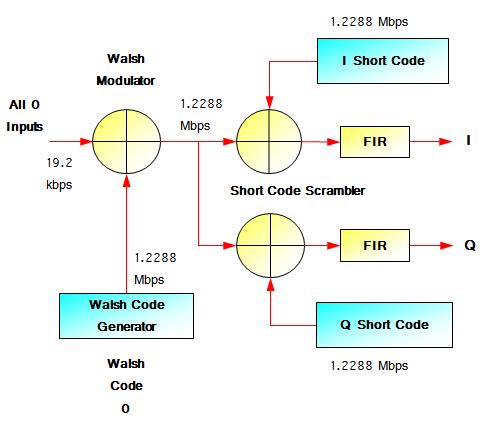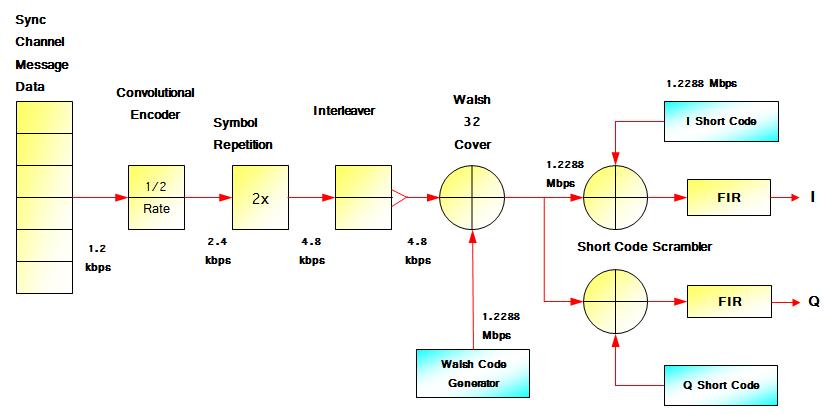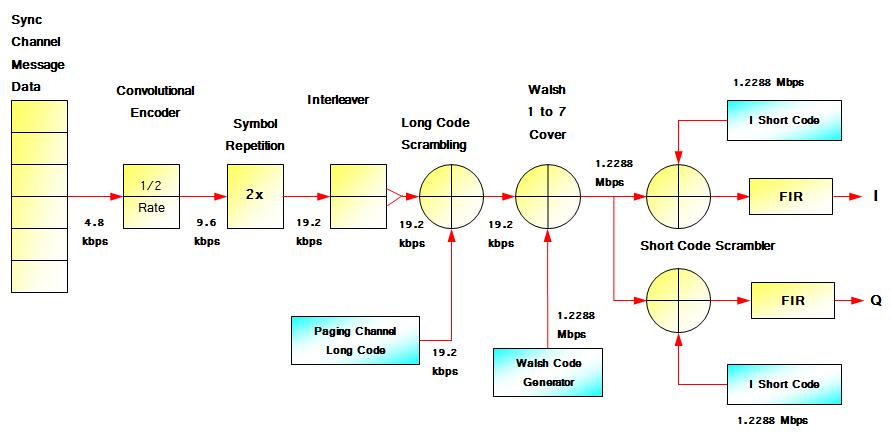Pilot Channel Physical Layer
The Pilot channel is essentially the short codes operating on their assigned PN offset. This is accomplished by selecting Walsh code 0 which is 64 zeroes (remember, the first code in any Walsh code set is always composed of all zeroes) as the Walsh code modulation data. In addition, the channel data coming into the Walsh modulator is also all zero which results in an all zero output.
 In practice, the Walsh modulator can be eliminated as only the short code hardware needs to be implemented for a channel generating a pilot.
In practice, the Walsh modulator can be eliminated as only the short code hardware needs to be implemented for a channel generating a pilot.
Sync Channel Physical Layer
The Sync channel is coded in manner similar to a traffic channel except that the long code scrambling is not needed. The actual messaging data for the sync channel runs at 1,200 bps. This data is first passed through a half-rate covolutional encoder which doubles the data rate to 2,400 bps. The encoded data is then repeated (also increases the processing gain by 3 dB) to bring the data rate to 4,800 bps.
 The data is then interleaved and then passed on to the Walsh modulator. Since the data rate at this point is only 4,800 bps, the output of the Walsh modulator is Walsh code 32 (or the logical NOT of Walsh code 32) repeated four times for each 4,800 bps bit. The signal is then scrambled against the short codes.
The data is then interleaved and then passed on to the Walsh modulator. Since the data rate at this point is only 4,800 bps, the output of the Walsh modulator is Walsh code 32 (or the logical NOT of Walsh code 32) repeated four times for each 4,800 bps bit. The signal is then scrambled against the short codes.
This coding provides a total of 30 dB of processing gain (a full rate traffic channel at 9,600 bps gets 21 dB)! The extra processing gain helps mobiles receive the critical timing information of the Sync channel error free.
Paging Channel Physical Layer
The paging channel message data runs at either 4,800 or 9,600 bps (called half or full rate operation). Normally half rate is used since it provides an extra 3 dB of processing gain. This makes the paging channel message reception more robust. Like a Traffic channel, the Paging channel uses a half-rate convolutional encoder.
 However, when operating in the half-rate mode, the output of the convolutional encoder is repeated to provide the extra 3 dB of processing gain (waveform redundancy). Following the interleaving operation, the paging channel data is scrambled against a special long code.
However, when operating in the half-rate mode, the output of the convolutional encoder is repeated to provide the extra 3 dB of processing gain (waveform redundancy). Following the interleaving operation, the paging channel data is scrambled against a special long code.
The paging channel long code is derived from a pre-defined bit pattern plus the paging channel number and the Pilot channel’s PN offset. The long code scrambled data is then Walsh modulated with Walsh code 1 (for the first Paging channel) and then scrambled with the short codes.